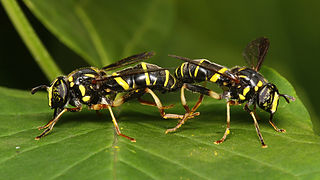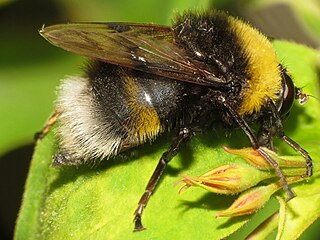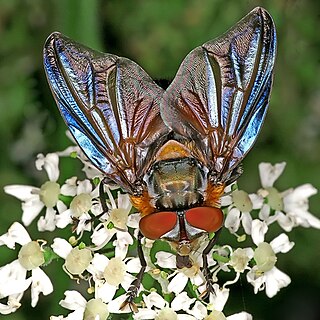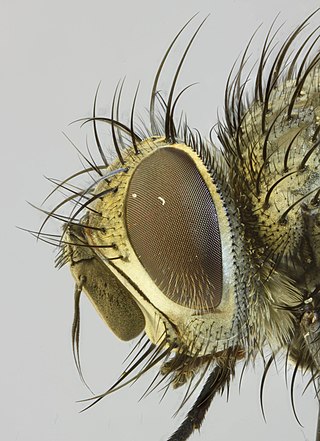
Pierre-Justin-Marie Macquart was a French entomologist specialising in the study of Diptera. He worked on world species as well as European and described many new species.

Syritta is a genus of hoverflies, family Syrphidae.

Xylota is a Holarctic genus of hoverflies similar in structure to the related genera Chalcosyrphus and Brachypalpoides. As the larvae are saprophytic they're usually found in rotting wood. The adult flies are generally associated with woodland and woodland edges and can often be seen running over the upper sides of leaves. Unlike other syrphids the adults of many species rarely visit flowers preferring instead to gather pollen from leaf surfaces. There are over 100 described species of which 12 can be found in Europe. Seven species have been recorded in Britain. Identification of species has been difficult and identifiction by photographs is risky.

Spilomyia is a genus of hoverflies. Many species in the genus show Batesian mimicry of wasp models, including black and yellow patterns and modified antenna shape.

Exorista is a genus of flies in the family Tachinidae.

Prosena is a genus of flies in the family Tachinidae.

Lydina is a genus of flies in the family Tachinidae.

Platycheirus is a large genus of hoverflies. They are also called sedgesitters.

Pocota is a genus hoverflies, from the family Syrphidae, in the order Diptera.

Tropidia is a genus hoverflies, from the family Syrphidae, in the order Diptera.

The Brachyopini is a tribe of hoverflies. Unlike many members of this family these flies are generally darker and less colourful though some genera contain species with an attractive metallic lustre e.g. Chrysogaster. Some like Brachyopa are associated with sap runs where their larvae feed on decaying sap. Others are found in boggy areas where their often semiaquatic larvae feed on decaying organic matter.

The Volucellini is a tribe of hoverflies.

Dexiini is a tribe of flies in the family Tachinidae.
Palumbia is a genus of hoverflies from the family Syrphidae, in the order Diptera.

Phasiinae is a subfamily of flies in the family Tachinidae. Except for the small tribe Strongygastrini members of this subfamily attack only Heteroptera.

Beridinae is a subfamily of soldier flies in the family Stratiomyidae.

Phryxe nemea is a species of fly in the family Tachinidae.
Blerina is a subtribe of hoverfly in the family Syrphidae.
Istocheta cinerea is a species of fly in the family Tachinidae.

















